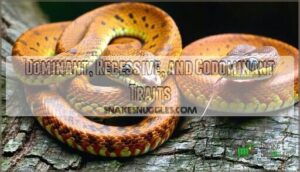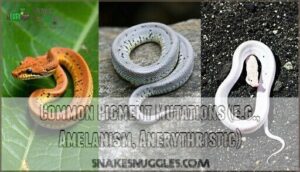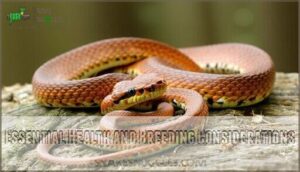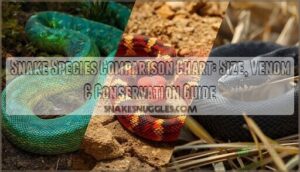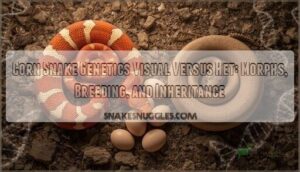This site is supported by our readers. We may earn a commission, at no cost to you, if you purchase through links.
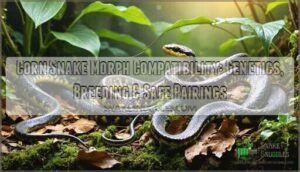
Most color morphs like amelanistic, anerythristic, and hypomelanistic can safely interbreed since they affect pigment production without causing health issues. However, sex-linked traits and epistatic interactions can produce unexpected outcomes, so you’ll want to use Punnett squares to predict offspring ratios before committing to a pairing.
The key isn’t just creating visually striking morphs—it’s maintaining genetic diversity while prioritizing snake health, which means understanding which combinations improve vitality and which ones you should skip entirely.
Table Of Contents
Key Takeaways
- Safe corn snake breeding requires understanding genetic inheritance patterns (dominant, recessive, codominant) and avoiding lethal combinations like Stargazer pairings or morphs with neurological defects that compromise welfare.
- Most color morphs (amelanistic, anerythristic, hypomelanistic) can safely interbreed since they only affect pigmentation, but sex-linked traits and epistatic interactions can produce unexpected outcomes that demand Punnett square predictions before pairing.
- Maintaining genetic diversity is as critical as creating visually striking morphs—responsible breeding means prioritizing snake health over market trends and sometimes walking away from pairings that risk hidden genetic disorders.
- Beyond genetics, successful breeding depends on proper nutrition, brumation cycles, temperature control (82°F incubation), and ethical practices that reject morphs causing suffering (like scaleless variants with 90%+ shedding problems).
Key Genetics Behind Corn Snake Morphs
Understanding corn snake genetics starts with recognizing how traits pass from parents to offspring through different inheritance patterns.
Here are the core mechanisms behind the stunning morphs you see today.
Dominant, Recessive, and Codominant Traits
When you’re ready to breed corn snakes for specific morphs, understanding how traits pass from parent to offspring becomes the foundation of every pairing decision you’ll make. Three genetic principles—dominant, recessive, and codominant trait inheritance—determine phenotype expression in corn snake morphs:
- Dominant alleles express visually in every snake that carries them, requiring just one copy
- Recessive traits need two copies to appear, hiding in heterozygous genotypes
- Codominant allele interactions blend characteristics when paired together
- Punnett squares predict genotype ratios and offspring outcomes before breeding
- Phenotype expression varies based on which genetic principles control each morph
Gene Expression and Epistasis
Understanding how traits pass from parents to offspring is just the beginning—what really shapes a corn snake’s final appearance is how those genes actually turn on, interact, and sometimes override each other through a process called epistasis.
Modifier genes work behind the scenes to tweak how traits actually look, sometimes pushing outcomes beyond what basic genetics would predict.
When one gene masks or changes how another expresses itself—a process called epistasis—you can end up with completely unexpected colors or patterns.
Regulatory elements control gene expression timing and intensity, while environmental influence and epigenetic inheritance add layers that affect how genetic inheritance patterns unfold in your breeding projects.
Sex-Linked Inheritance Patterns
While most corn snake genetics play out the same way in males and females, a handful of morphs break that rule entirely—they’re tied directly to the sex chromosomes, creating breeding outcomes that shift depending on whether your snake is male or female.
Sex chromosome alleles behave differently than autosomal genes because males carry only one copy, making them hemizygous for sex-linked traits. This hemizygous morph expression means recessive sex-linked inheritance appears more frequently in males, skewing sex ratios in certain pairings and sometimes triggering sex-linked lethality when dosage compensation effects fail in homozygous females.
Common Pigment Mutations (e.g., Amelanism, Anerythristic)
Most corn snake morphs you’ll encounter come down to just a few pigment mutations—amelanism wipes out black pigment, anerythrism removes red and yellow, and variations on these themes account for hundreds of the color patterns breeders work with today.
Three genetic mechanisms drive these color outcomes:
- Amelanistic mutations disrupt melanin-producing chromatophore impacts, leaving vibrant reds and oranges with amelanism effects that eliminate dark borders entirely.
- Anerythrism risks stem from pigment cell mutations blocking erythrin and xanthin, producing grayscale corn snake morphs through altered pigment production pathways.
- Combining both genetic mutations creates snow morphs—pure white snakes where corn snake genetics stack recessive traits for striking results.
Morph Compatibility and Safe Pairings
Understanding which morphs pair safely is the foundation of responsible breeding. Let’s explore compatible combinations, genetic risks to avoid, and the special considerations that come with hybridization.
Which Morphs Can Be Safely Bred Together?
You can safely breed most corn snake morphs together, but knowing which combinations work best starts with understanding how different genetic traits interact in the offspring. A morph compatibility chart helps you predict visual outcomes and avoid inbreeding or lethal gene combinations that harm hybrid vigor.
When you pair compatible morphs, you can predict outcomes with confidence because these combinations follow clear genetic patterns.
| Parent Morph A | Parent Morph B | Expected Outcome |
|---|---|---|
| Amelanistic | Anerythristic | Snow (double recessive) |
| Bloodred | Normal | 50% Bloodred, 50% het Bloodred |
| Okeetee | Striped | Pattern combination variations |
Risks of Combining Certain Morphs
Although most morphs pair safely, combining certain traits brings documented genetic health risks. Scaleless shedding issues and Palmetto eye defects represent the clearest examples of morph-specific complications. Retrotransposon mutations underlying some color variations don’t cause lethal gene combinations, but scale defects in homozygous Scaleless pairings show over 90% shedding problems.
Corn snake breeders are still developing new and interesting corn snake morphs. Ethical practices demand awareness of these incompatible gene interactions before breeding, thereby making certain genetic disorders don’t compromise your snakes’ welfare.
Hidden Genetic Disorders and Lethal Combinations
Beyond visible traits, lethal allele persistence lurks in your breeding population when both parents carry hidden recessive genes. Carrier detection methods like genomic screening reveal polygenic trait risks before you pair snakes, protecting genetic health and snake health.
Scaleless morph concerns extend beyond shedding—breeding related morphs amplifies the chance of lethal genes surfacing. The development of scales is influenced by somitic positional information.
You won’t spot these genetic disorders until two carriers breed together, which is why solid breeding ethics and upfront genetic testing aren’t optional—they’re essential protection.
Hybridization With Other Snake Species
Crossing corn snakes with related species like rat snakes opens genetic doors that nature never intended—and sometimes, that’s exactly where innovative morphs like the Scaleless are born. However, interspecific hybridization brings hybrid fertility concerns and ethical implications you can’t ignore.
Species compatibility doesn’t guarantee viable hybrid offspring, and hybrid morphs may show reduced fertility or health issues. Conservation impact matters too—releasing hybrids risks diluting wild populations.
While hybrid vigor occasionally strengthens traits, responsible breeders weigh these ethical implications carefully before pursuing such pairings.
Essential Health and Breeding Considerations
Before you pair your corn snakes, you need to make sure they’re physically ready and genetically sound. Here’s what matters most when breeding for healthy offspring and long-term success.
Nutrition and Conditioning for Breeding Season
Proper nutrition during the months leading up to breeding season can make the difference between healthy, viable clutches and disappointing reproductive failure. Your pre-breeding diet should include appropriately sized frozen-thawed rodents every 5-7 days to build nutritional reserves and ideal body condition. Females especially need substantial energy stores before brumation feeding tapers off.
Water matters more than you might think—make sure your snake always has access to fresh water.
Post-laying recovery demands immediate nutritional aid to replenish depleted resources.
Identifying and Preventing Breeding Injuries
Breeding season brings more than just the excitement of potential clutches—it can also expose your snakes to bite wounds, tail injuries, and stress-related health complications if you’re not watching closely. Mating aggression between breeding pairs requires careful supervision—separate them immediately if biting escalates beyond normal courtship.
Check for enclosure hazards like sharp edges that cause shedding problems or abrasions. Bite prevention starts with observing body language, while post-breeding care ensures both snakes recover fully before returning to normal routines.
Maintaining Genetic Diversity
When you’re chasing that next stunning morph, genetic problems can pile up quietly if you’re breeding from too small a gene pool. Inbreeding depression gradually weakens disease resistance and fertility.
Outcrossing brings in fresh alleles and hybrid vigor, strengthening your genetic diversity. Gene flow from unrelated bloodlines counters the genetic drift and rising mutation rates that otherwise limit your breeding choices.
Without genetic variation in the mix, natural selection has nothing to work with.
Setting Up for Successful Breeding
Once you’ve got your breeding pairs selected and your genetics mapped out, the next step is setting up the right environment.
Now we need to dial in the physical conditions—enclosure size, temperature cycling, and the rest—that actually trigger breeding behavior.
Habitat Requirements and Enclosure Setup
Your adult corn snakes need a spacious, well-equipped home long before you start thinking about pairing them up. A proper corn snake habitat setup starts with these essentials:
- 40-gallon enclosure minimum for adult breeding pairs
- Thermal gradient from 85°F warm side to 75°F cool side
- Substrate choice like aspen shavings, paper bedding, or cypress mulch
- Hides & decor including branches and foliage for security
- Water access via sturdy dish for soaking and maintaining humidity levels
Get all of this right, and you’re setting the stage for successful breeding.
Temperature, Lighting, and Brumation
Once you’ve got the right space set up, controlling temperature cycles becomes the key that primes your corn snakes’ breeding instincts. You’ll need to simulate seasonal cycles through a brumation period—basically hibernation for reptiles.
Drop temperatures gradually to around 50-60°F for 8-12 weeks during winter months. This cooling phase triggers hormonal changes that prime your snakes for reproduction. When you slowly raise the temperature back to your standard thermal gradient in spring, their bodies recognize it’s time to breed.
Lighting needs stay minimal during brumation but return to normal 12-hour cycles afterward.
Pairing, Courtship, and Mating Behavior
After temperatures climb back to breeding range, your snakes will naturally start showing interest in each other—but timing the introduction requires some finesse. Courtship rituals begin when you place breeding pairs together, with males initiating through chin rubbing and body alignment.
Mating behavior usually peaks within days post-brumation, when reproductive success rates run highest. Copulation can last several hours, and pairing duration of 3-5 days maximizes mating frequency without stressing your snakes.
Incubation and Egg Care
Successful mating marks the beginning of a new phase—one where your attention shifts from courtship to the careful monitoring of egg development and environmental precision.
Egg incubation demands steady temperature stability around 82°F and egg humidity between 80-100%, tracked with a reliable hygrometer. Incubating corn snake eggs works best using incubation mediums like vermiculite or perlite.
Most eggs hatch without intervention, though hatching assistance may help stragglers. Post-hatch care focuses on first shed and feeding readiness.
Ethical and Advanced Breeding Practices
Breeding corn snakes responsibly means balancing innovation with welfare, whether you’re perfecting a bloodline or exploring state-of-the-art techniques. Here’s how modern breeders approach ethics, genetics, and market realities.
Responsible Breeding and Animal Welfare
Breeding isn’t just about chasing stunning patterns—it’s about protecting genetic health and ensuring your animals thrive. Certain morphs, like scaleless and sunkissed, cause real suffering through neurological problems and behavioral issues that affect quality of life.
Ethical breeding means you avoid pairings that compromise welfare, even when they’d produce visually striking offspring. Hybridization introduces unpredictable health risks, while maintaining genetic diversity protects future generations from inherited disorders.
Ethical breeding prioritizes animal welfare over visual appeal, avoiding pairings that risk health problems even when offspring would be stunning
At its core, responsible breeding puts animal welfare ahead of market trends.
Selective Breeding Vs. Line Breeding
When you’re chasing specific traits without sacrificing long-term viability, understanding the distinction between selective breeding and line breeding becomes your roadmap to success.
Selective breeding boosts desirable traits by pairing unrelated snakes with complementary phenotypes, maximizing hybrid vigor and genetic variation. Line breeding involves mating closely related individuals to achieve trait fixation, but it carries inbreeding risks like genetic bottleneck effects.
The five key points break down like this:
- Selective breeding pairs unrelated morphs for diverse offspring with boosted vigor
- Line breeding concentrates desirable traits through pedigree analysis and controlled relatedness
- Trait boosting happens faster with line breeding but risks hidden genetic disorders
- Genetic variation stays healthier with selective breeding approaches
- Inbreeding risks increase dramatically after three generations of line breeding
Artificial Insemination and Genetic Preservation
As breeding technology evolves, artificial insemination creates opportunities that natural pairing simply can’t provide—think preserving rare morphs from aging males or overcoming incompatible breeding behaviors.
Sperm collection and genetic banking extend breeding windows considerably, letting you maintain sperm viability for months while safeguarding genetic diversity.
These sophisticated breeding techniques allow genetic preservation of valuable lines and fuel diversity research, pushing boundaries in rare morphs that would otherwise vanish from captive populations.
Market Trends and High-Value Morphs
The corn snake market is growing fast—expect a 12% annual jump through 2034, driven by Consumer demand shifts toward Designer snakes with rare patterns.
Morph price drivers like Palmetto and Scaleless reach $300–$2,000, while common color morphs hold steady at $40–$100. Rare morph values spike when supply tightens.
Ethical market practices are essential as Breeding market growth accelerates and hobbyists chase unique Corn Snake Morphs.
Frequently Asked Questions (FAQs)
How do you calculate morph outcomes in breeding pairs?
You calculate breeding outcomes using Punnett Squares to map allele combinations from each parent. These grids reveal genetic ratios and expected phenotypes based on inheritance patterns.
Understanding probability calculations helps predict morph compatibility and breeding outcomes across dominant, recessive, and codominant traits.
What percentage of offspring inherit each parents morph?
Inheritance Probabilities depend entirely on whether each parent carries dominant, recessive, or codominant alleles. Using Punnett Squares, you can predict phenotype ratios and genotype prediction for expected outcomes.
Corn snake morph genetics follow fundamental genetic principles, allowing accurate morph probability calculations through inheritance patterns.
Can you breed different morph generations together safely?
Yes, you can safely breed different morph generations together. Outcrossing brings real benefits—hybrid vigor and reduced genetic bottlenecks—though you’ll need to understand inheritance patterns to avoid diluting the traits you’re after.
When done right, breeding across morph lines keeps your corn snake genetics healthy and diverse.
How do you test for hidden recessive genes?
How do you reveal what’s hiding beneath the surface? "What you see isn’t always what you get" rings especially true in genetics.
Test breeding remains your most reliable tool—pairing a suspect heterozygous snake with a known homozygous recessive partner lets the offspring reveal hidden alleles through Punnett Square predictions and pedigree analysis.
Whats the minimum clutch size for morph variety?
You’ll need at least 12–15 eggs to see meaningful morph frequency ratios. Smaller clutches don’t provide enough genetic diversity to reveal recessive traits reliably, and hatchling survival rates can reduce your final count substantially.
Conclusion
Getting corn snake morph compatibility right comes down to understanding genetics without losing sight of what matters most—your snakes’ well-being.
You’ve seen which pairings produce eye-catching morphs and which ones create real problems, from lethal gene combos to serious neurological issues.
Don’t risk your snakes’ health chasing flashy results without grasping how traits pass down. Work through Punnett squares, keep bloodlines diverse, and accept that responsible breeding sometimes means passing on a pairing—even when the potential offspring look incredible on paper.
- https://pmc.ncbi.nlm.nih.gov/articles/PMC7584913/
- https://community.morphmarket.com/t/corn-snake-genetics-question/21649
- https://reptilesmagazine.com/color-patterns-of-corn-snakes-determined-by-single-gene/
- https://robinheinen.com/herpetology/breeding-projects/
- https://snakeinsider.com/how-much-is-a-corn-snake/

